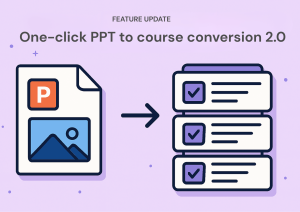
Create e Learning Courses: Best Practices and Tips
- Author: Urban Rotar
- Published:

How do I start creating an eLearning course?
Begin by defining clear course objectives and understanding your target audience. Conduct a needs analysis to identify knowledge gaps and decide what content is necessary. Then, outline your course structure, develop engaging multimedia content, and plan assessments to track progress.
What tools do I need to create an eLearning course?
You’ll need a learning management system (LMS) to organize and deliver content, along with tools for creating multimedia like video, audio, quizzes, and interactive elements.
How can I make my eLearning course engaging?
Incorporate videos, interactive quizzes, and real-world scenarios. Use gamification techniques like badges and certificates to motivate learners, and tailor content to different learning styles.
Key Takeaways - Create e learning Courses:
Start by clearly defining your course objectives to guide content creation and meet learners’ needs.
A thorough needs analysis helps identify gaps in current training and learner expectations.
Use multimedia, quizzes, and gamification to create engaging and interactive eLearning content.
Creating tokens in crypto is like designing a custom currency for digital transactions.
Track learner progress and regularly gather feedback to keep courses relevant and impactful.
Planning and Preparation
Before jumping into creating your eLearning course, the foundation must be solid. Proper planning ensures that your course not only delivers content but also engages and meets the needs of your learners. Effective planning is crucial for developing engaging and effective learning content that enhances learner retention and progress tracking.
Step 1: Define Your Course Objectives
The first and most important step when you create e-learning courses is to define your objectives. Ask yourself: What’s the purpose of this course? A clear learning objective will guide the entire creation process. Defining these objectives helps you focus on what learners need to achieve by the end of the course. Whether you aim to teach a new skill, reinforce knowledge, or provide updates on a subject, a clear course objective is critical.
Identify the target audience and tailor the content to meet their specific needs. Are they beginners, or do they have prior knowledge? Different audiences need different approaches, so consider their level of experience and background. Set SMART goals—specific, measurable, achievable, relevant, and time-bound—so the learners and instructors have a clear idea of the course’s purpose.
Step 2: Conduct a Needs Analysis
Conducting a thorough needs analysis helps to uncover gaps in your current training program. It provides insight into what your learners are missing and what they need most from the eLearning course. Consider their existing knowledge, technical abilities, and demographic data when analyzing their needs. The key here is to align your course content with the learner’s expectations and the practical skills they want to gain.
By assessing these areas, you’ll get a clearer picture of the content you need to create and how best to structure it. If your audience is not tech-savvy, you may want to simplify the technical aspects of the course. Needs analysis also gives direction for creating a structured, purposeful learning journey, leading learners toward success.

Designing Your eLearning Course
Now that you have a strong foundation in place, it’s time to design your course. Course design is where the magic happens—this is when your ideas start coming together into a structured, organized format.
Step 3: Create a Course Outline
A course outline acts as the backbone of your eLearning course. It helps you organize your material in a logical, didactic order that enhances learning. Begin by dividing the course into topics and subtopics to create a general framework. Each section should build on the previous one, guiding the learner from basic to more advanced concepts.
Your outline should not only include text but also indicate where multimedia elements like videos, infographics, or quizzes will be placed. These elements add variety and engagement to the learning experience, making it more interactive and memorable for the learners.

Step 4: Develop Engaging Content
This is where you can get creative! Use a combination of videos, interactive quizzes, and real-world scenarios to craft content that resonates with different learning styles. Adding interactive elements like quizzes helps learners retain information by allowing them to apply what they’ve learned.
Gamification is another powerful strategy that can significantly boost engagement. By incorporating elements like badges, points, or certificates of completion, you can motivate learners to push through challenging sections of the course. Relating the content to practical, real-world applications can make even complex topics easier to grasp.
Creating Your Online Course
With the outline and content ready, it’s time to bring your course to life. The development phase involves transforming your ideas into a tangible eLearning course.

Step 5: Write a Script and Create a Storyboard
A well-written script is the heart of any good eLearning course. It helps transform dense subject matter into digestible and engaging lessons. Start by writing a script that conveys the key points of each topic. Keep it conversational and clear to ensure learners stay engaged throughout.
A storyboard is an essential tool that helps you map out how each piece of content will appear. From text and images to videos and quizzes, a storyboard visually organizes all the elements. Include multimedia like charts, icons, and animations to enhance understanding and retention.

Step 6: Record or Add Audio and Video
Adding audio and video elements can elevate your eLearning course to the next level. Whether you’re recording a voiceover or embedding a tutorial video, these components add another layer of engagement. Video tutorials, for instance, can be recorded using simple tools, and no prior training is necessary to make them effective.
Good audio and video can make the course more dynamic and enjoyable. Ensure the tone matches the learning objective, whether it’s formal for professional training or lighthearted for a creative topic.
Assessing and Evaluating
The assessment phase is where you can track learner progress and evaluate how well your course performs.

Step 7: Add Assessments and Knowledge Checks
Incorporating quizzes and assessments throughout your course provides immediate feedback to learners and allows them to track their own progress. Quizzes, especially those built into a learning management system, help learners solidify their understanding before moving on to new topics.
Assessments also serve as a checkpoint for the course creators, allowing them to see if learners are hitting key learning objectives or if areas of the course need improvement.
Step 8: Track Learner Progress and Engagement
It’s important to keep track of how many learners are engaging with your content, along with metrics like course completion rates, time spent on each module, and quiz performance. This data can provide insight into what’s working and what might need tweaking. Most learning management systems offer tools to analyze this information.
Don’t just focus on numbers—analyze learner feedback too. Surveys can help you gauge satisfaction and pinpoint areas where improvements are needed. Observing how learners apply what they’ve learned in real-world settings is another valuable indicator of course effectiveness.
Implementing and Maintaining
Once the course is built and tested, it’s time to launch it. But your job doesn’t stop there—regular updates and improvements keep your course fresh and relevant.
Step 9: Apply UI/UX Best Practices for eLearning Courses
Creating an eLearning course isn’t just about the content; it’s also about how that content is presented. Applying UI/UX best practices can significantly enhance the learning experience, making it more engaging and effective for learners.
Start by ensuring a clear and consistent layout throughout your eLearning course. A well-organized interface helps learners navigate the course easily, reducing frustration and improving focus. Choose a color scheme that is visually appealing yet easy on the eyes—this can help maintain learner engagement without causing visual fatigue.
High-quality images and graphics are essential. They break up text and make the learning experience more dynamic. However, ensure these visuals are relevant and add value to the content. Accessibility is another critical factor; your course should be easily accessible on various devices and browsers to accommodate all learners.
Language matters too. Use clear and concise language to convey your points effectively. Avoid jargon unless it’s necessary and well-explained. Navigation should be intuitive—learners should always know where they are in the course and how to move forward or revisit previous sections.
Interactive elements like quizzes, games, and simulations can significantly boost engagement. These elements not only make the course more enjoyable but also help reinforce learning by allowing learners to apply what they’ve learned. Finally, incorporate feedback mechanisms to help learners track their progress and stay motivated. This could be through instant quiz results, progress bars, or completion certificates.
By applying these UI/UX best practices, you can create an eLearning course that is not only visually appealing but also provides an effective and enjoyable learning experience for your learners.
Step 10: Publish and Deliver Your eLearning Course
When you’re ready to publish, consider the format that will best suit your platform and goals. You can offer your course through a learning management system (LMS), which organizes and delivers the content seamlessly to learners. It’s also crucial to make your eLearning course accessible to everyone, including those with impairments.
LMS platforms also allow for easy updates, which means you can refine and tweak the course based on feedback or new industry standards.
Step 11: Get Feedback from Colleagues and Share Your Course
Once your eLearning course is ready, it’s crucial to gather feedback and share it with your intended audience. This step ensures that your course meets its learning objectives and provides a valuable learning experience.
Start by sharing your course with colleagues. Ask them to review the content, design, and overall learning experience. Their feedback can provide fresh perspectives and highlight areas you might have overlooked. Use this feedback to make necessary improvements, ensuring your course is as effective as possible.
Next, share the course with your learners. Provide clear instructions on how to access and complete the course. A learning management system (LMS) can be incredibly useful here, as it organizes and delivers the content seamlessly. An LMS also allows you to track learner progress and provide feedback on their performance, helping you understand how well the course is meeting its objectives.
Encourage learners to provide feedback on the course. This can be done through surveys, discussion forums, or direct communication. Use this feedback to make continuous improvements, ensuring that each iteration of your course is better than the last.
By getting feedback from colleagues and learners, you can refine your eLearning course to ensure it is effective and engaging. This iterative process helps you create a course that not only meets learning objectives but also provides a valuable and enjoyable learning experience.
Step 12: Continually Gather Feedback and Improve
The best eLearning courses are constantly evolving. Learner needs change, industries advance, and technology improves—so your course should too. Regularly collecting feedback and keeping an eye on trends ensures that your content stays relevant.
One simple way to gather feedback is through a Net Promoter Score (NPS) survey, which helps gauge learner satisfaction. Don’t forget to involve stakeholders from management to get insight into key performance indicators and broader company goals.

Best Practices for Creating Online Courses
When creating eLearning courses, a few best practices can help you deliver content that not only informs but engages.
1. Use a learning management system to create and deliver courses effectively.
2. Craft custom eLearning courses that cater to your specific audience’s needs.
3. Rely on instructional design principles to ensure your course is both engaging and effective.
4. Evaluate your course regularly to keep it up-to-date and effective.
5. Continuously gather learner feedback to improve engagement.
Conclusion on Creating e Learning Courses
Creating an eLearning course requires thought, effort, and ongoing refinement. By following the steps outlined here, you’ll have a course that not only educates but also engages and inspires. Start with clear objectives, engage learners through a variety of content formats, and continuously seek ways to improve. Whether you’re delivering training to employees or sharing knowledge with a global audience, your eLearning course can make a lasting impact. Don’t forget: Regular feedback and updates are key to keeping your course fresh and relevant in the ever-changing online landscape.



